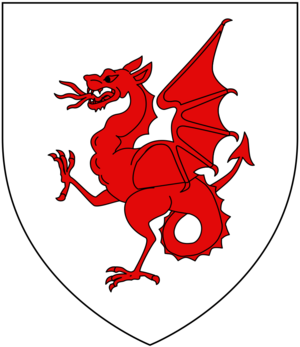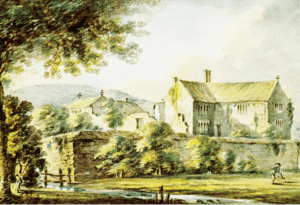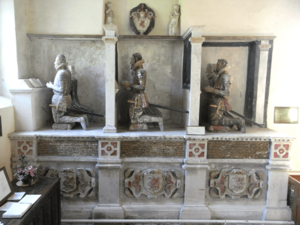Bernard Drake facts for kids
Sir Bernard Drake (around 1537 – April 10, 1586) was an English sea captain from Ash in Musbury, Devon. He was a distant relative of the famous Admiral Sir Francis Drake. They even had a disagreement about their family crests! Sir Bernard and Sir Francis shared the same grandparents, but Sir Bernard came from an older branch of the family.
Contents
Family Background
Sir Bernard Drake was the oldest son of John Drake (who died in 1558) and Amy Grenville (who died in 1578 or 1579). His mother, Amy, was the daughter of Sir Roger Grenville, a powerful lord from Devon and Cornwall.
Sir Bernard's brother, Richard Drake, worked for Queen Elizabeth I. Sir Bernard also had an aunt, Alice Drake, who married Walter Raleigh. This made her the stepmother of the famous explorer, Sir Walter Raleigh.
Sea Voyages and Adventures
Sir Bernard's life became more exciting when he started working with Sir Humphrey Gilbert. This connection might have come through his relatives, Richard Grenville and Walter Raleigh.
In 1582, Sir Bernard invested in a company created by Gilbert to explore North America. However, he didn't sail overseas himself until 1585. By then, he had joined forces with Sir Walter Raleigh and John Gilbert (Humphrey's brother) for activities related to the Roanoke Colony in what is now North Carolina.
In May 1585, the Spanish government stopped English ships from leaving Bilbao harbor. Queen Elizabeth I then asked Raleigh to send Drake to warn English fishermen in Newfoundland about this problem. Drake was also told to capture Spanish ships. He changed his plans to sail to the West Indies and instead headed for Newfoundland in July.
Success in Newfoundland
Drake's trip to Newfoundland was very successful. First, he captured a ship carrying sugar from Brazil to Portugal. Then, he warned the British fishermen in Newfoundland that they could no longer sell their fish in Spain. He then captured several Spanish and Portuguese fishing boats. He sent some of his own ships back to England with these captured vessels.
Working with George Raymond, who was also connected to Raleigh, Drake captured more Spanish trading ships near the Azores. These ships were carrying sugar, wine, and ivory. He also took a French ship with gold. In total, Drake's expedition captured about 20 ships! This made a huge profit, estimated at 600%. Sir Bernard and his son, John, received the four most valuable ships as their share.
This voyage was also important because it took away a lot of dried fish that the Spanish navy and merchant ships needed for their own journeys. This made the Spanish government stop their ships from sailing to Newfoundland. The Portuguese fishing fleet was also greatly weakened by their losses to Drake.
Family and Children
Sir Bernard Drake married Gertrude Fortescue. She was the daughter of Bartholomew Fortescue from Filleigh, North Devon. Gertrude's brother was Richard Fortescue, and Sir Bernard put up a special monument for him in Filleigh Church.
Sir Bernard and Gertrude had six children:
- Hugh Drake (died 1589), who passed away in Portugal. He did not have any children.
- John Drake (died 1628), who lived at Mount Drake and Ashe. His son, Sir John Drake (died 1636), was the grandfather of John Churchill, 1st Duke of Marlborough, a very famous military leader.
- Marie Drake, who married a man named Tynsley from Lincolnshire.
- Mary Drake, who married John Sherman. Their daughter, Alice Drake, was an ancestor of the Earls of Egmont.
- Eleanor Drake, who married John Button.
Death and Legacy
On January 9, 1586, Queen Elizabeth I made Bernard Drake a knight to honor his success.
A few months later, some Portuguese prisoners, whom Drake had held in Exeter Castle, were put on trial. The prisoners were very sick. Sadly, an illness spread from them during a difficult trial in Exeter in March 1586. Many people, including the judge and jurors, became ill and died from this sickness. Sir Bernard Drake himself became ill. He tried to go home but died in Crediton on April 10, 1586. He was buried two days later. For over a year, a widespread illness, like a fever, affected Devonshire.
Sir Bernard's son, John, inherited the family home at Ashe and the profits from the Newfoundland voyage.
Family Monument
A large monument was built by Sir Bernard's son, John, in St. Michael's Church in Musbury. It shows three generations of the Drake family kneeling as if in prayer, each with their wife.
Under the middle couple, Sir Bernard and his wife Gertrude, there is an inscription. It says that Sir Bernard Drake and his wife Dame Gertrude are buried there. It also mentions their children: John, Hugh, Marie, Margaret, and Helen. Sir Bernard died on April 10, 1586, and Dame Gertrude was buried on February 12, 1601. Their son, John Drake, put up this monument in 1611 to remember them.
Family Crest
The family crest of the ancient Drake family of Ash is a red dragon-like creature called a wyvern on a silver background. You can see this crest on the monument to Sir Bernard in Musbury Church.
Sir Francis Drake, the famous sea-captain, was a very distant relative of Sir Bernard. When Sir Francis was made a knight by Queen Elizabeth in 1581, he started using the same family crest as the Drakes of Ash. This made Sir Bernard very upset!
A story tells that Sir Bernard even hit Sir Francis in court because of this. Queen Elizabeth was very angry about this behavior. To teach Sir Bernard a lesson and to honor Sir Francis, she gave Sir Francis a brand new family crest. This new crest showed his amazing journey around the world. It featured a ship on a globe and, as a special insult to Sir Bernard, it showed a red wyvern (like Sir Bernard's crest) hanging upside down!
Sir Bernard was not happy, but he had to accept it. He famously said that "though Her Majesty might give Sir Francis a nobler, yet she could not give an antienter coat than his." Even with his new crest, Sir Francis Drake still sometimes used the old Drake of Ash crest, combining it with his new one.
|





